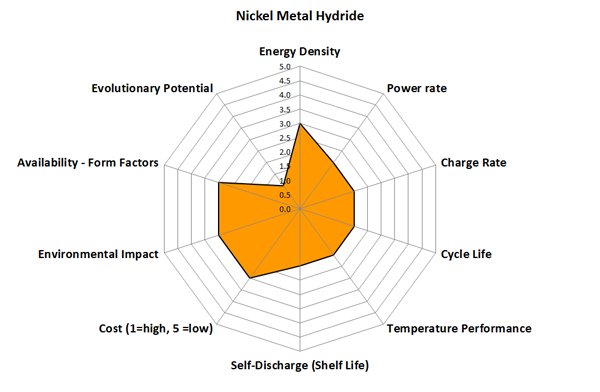www.meritsunpower.com

MERITSUN, the Best Lithium Energy Solution Provider.
Nickel Metal Hydride technology was developed during the 1970s and 1980s. Similar to a NiCd, NiMH utilizes a Nickel based positive electrode (the cathode) - Nickel Oxyhydroxide. The negative electrode (the anode) consists of a hydrogen-absorbing alloy that provides a much higher energy density than NiCd. NiMH produces a nominal cell voltage of 1.2V which allows it to be dropped in as a replacement for NiCd in many cases.
NiMH batteries were a welcome participant in the rapid commercialisation of mobile phones and laptop computers in the late 1980s and 1990s. While the technology offered dramatic improvements when compared to NiCd, NiMH has several key flaws that left it vulnerable for replacement by newer technologies such as Lithium Ion.
NiMH has a very high self-discharge rate, meaning that a fully charged battery can lose up to 30% of its charge per month. This can create supply chain issues where batteries can be fully discharged by the time they arrived at the end user. NiMH can also permanently loose capacity following prolonged storage at low states of charge.
As mobile phone technology advanced, creating smaller and smaller handsets, NiMH cell manufacturers found it difficult to follow suit as the manufacturing a thin NiMH cell is both difficult and expensive due to the problems of winding the relatively stiff electrodes into smaller and smaller cans. When mobile phones required batteries to be thinner than the 10mm diameter AAA size the cell manufacturers struggled to manufacture a reliable, cost effective prismatc cells and Lithium ion products quickly captured the market with their thinner profiles and higher energy density.
1. 30-40% higher energy density than NiCd
2. Drop in replacement for NiCd in many cases
3. Less prone to memory effect than NiCd
4. Simple to transport
5. Environmentally preferred over NiCd
1. Limited cycle life Vs NiCd
2. Poorer storage performance
3. Complex charging regimes
4. Higher self discharge than NiCd
5. Lower energy density than LiIon

The switchover from NiCd to NiMH in mobile phones was relatively rapid due primarily to the increased energy density. Just a few short years later, the use of NiMH in mobile phones was phased out by Lithium-ion (Cobalt Oxide and polymer) cells which offered far higher energy density and thinner packaging capability. With the market for NiMH cells for mobile phones in rapid decline the cell manufacturers developed the technology for high rate applications such as profesional cordless power tools and high temperature applications such as emergency lighting.
Today, the market for NiMH cells in portable electronic applicatiions is all but dead, but the technology has had success in hybrid electric vehicles and the cordless power tools mentioned above. Most cell manufacturers are rationalising the number of cell sizes they manufacture and there is consolidation between manufacturers as they adjust to match the shrinking market.
©1999-2023 MeriTech Power Limited | All Rights Reserved
We are here to help you! If you close the chatbox, you will automatically receive a responsefrom us via email. Please be sure to leave yourcontact details so that we can better assist